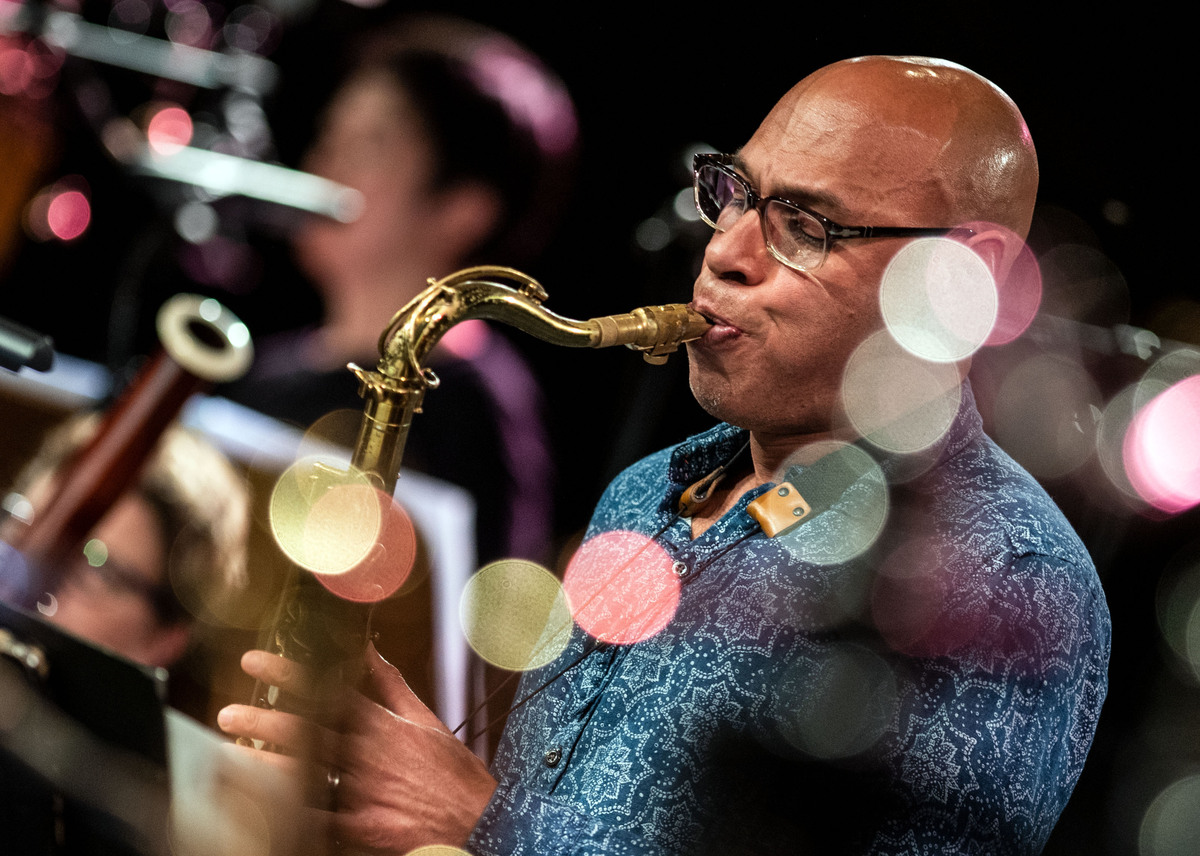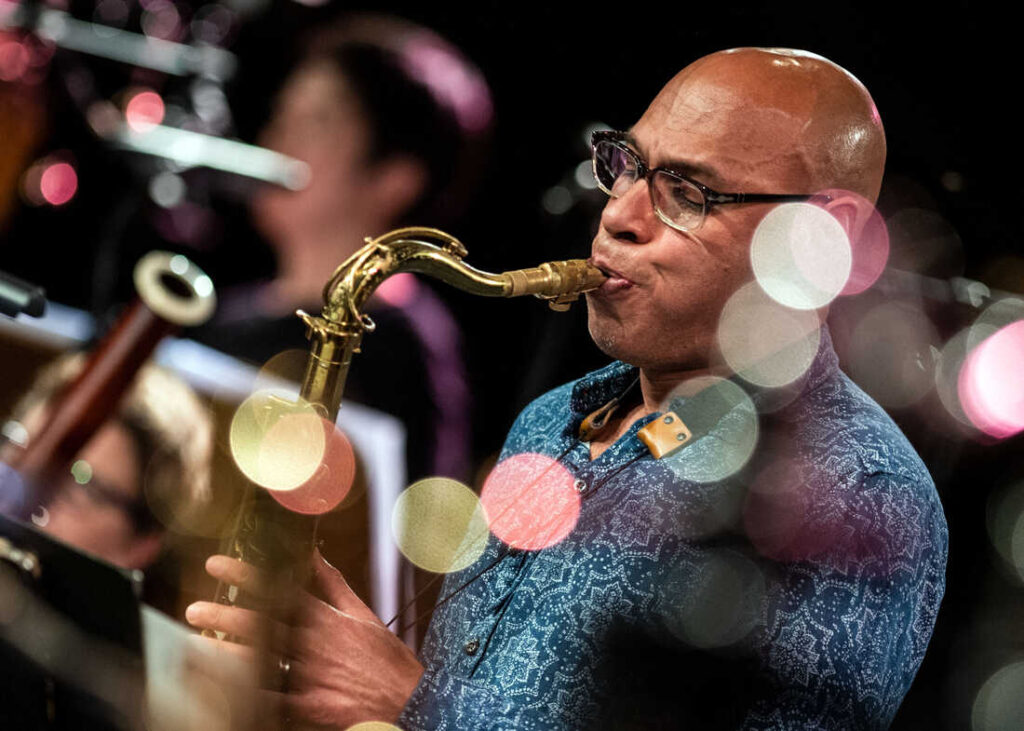Jazz saxophonist Joshua Redman plays in 2019. Swing is an essential component of nearly all kinds of jazz music. Physicists think that subtle nuances in the timing of soloists are key to creating that propulsive swing feel.
Bernd Thissen/picture alliance via Getty Image
hide caption
toggle caption
Bernd Thissen/picture alliance via Getty Image

Jazz saxophonist Joshua Redman plays in 2019. Swing is an essential component of nearly all kinds of jazz music. Physicists think that subtle nuances in the timing of soloists are key to creating that propulsive swing feel.
Bernd Thissen/picture alliance via Getty Image
For nearly a century, jazz musicians and scholars have debated the answer to a musical mystery. As legendary jazz trumpeter Louis Armstrong once put it, “What is this thing called swing?”
Swing has long been considered an essential component of almost all types of jazz, from traditional to bepop to post-bop. As Ella Fitzgerald and many others have sung, “It don’t mean a thing if it ain’t got that swing.” You might describe swing as a rhythmic phenomenon in jazz performances — a propulsive, groovy feeling that makes you want to move with the music.
Still, a precise definition of swing has long eluded musicians and scholars alike. As the Big Band era jazz trumpeter Cootie Williams once reportedly joked about swing, “Describe it? I’d rather tackle Einstein’s theory.”
Fittingly, physicists now think they’ve got an answer to the secret of swing — and it all has to do with subtle nuances in the timing of soloists.
YouTube
That elusive swing feel in performances
Ask a jazz musician what swing is, and you’re likely to get the same answer Christian McBride gave me.
“Swing is a feel,” says McBride, a multi-Grammy-winning jazz bassist, music educator and host of NPR’s Jazz Night in America. “There’s a certain language. There’s a certain inflection of rhythm.”
There’s one defining component of swing that’s easy to hear, and it has to do with how eighth notes are played. Instead of playing them straight, like this …
… in jazz these notes are swung, meaning the downbeats — or every other eighth note — is played just a little longer, while the offbeat notes in between are shortened, creating a galloping rhythm, like this.
But jazz musicians know that technique alone can’t explain swing — after all, even a computer can swing a note.
“A computer just ain’t — excuse my language – it just ain’t going to swing that hard, you know?” McBride says. “You still don’t get the real proper swing feel, which is a human feel.”
That swing feel happens as musicians interact in performance, McBride explains. “For me, I think you’ve got to lock people in and say, ‘OK, here’s where the time is, here’s what the rhythm is.’ And then everybody, collectively — the musicians and the listeners — can go, ‘Oh, yeah … that feels right.'”
But how exactly are musicians playing off each other to create that swing feel? That’s what Theo Geisel wanted to find out.
The physics of swing
Geisel is a theoretical physicist with the Max Planck Institute for Dynamics and Self-Organization and the University of Göttingen in Germany. He spent decades studying the physics of synchronization — for example, how the billions of neurons in your brain coordinate with each other. He’s also a passionate amateur saxophonist. He even has a band with other physicists. (They play at conferences.)
Geisel is now retired. That’s given him more time to use his theoretical physics toolkit to explore other mysteries of the universe, including this one: How do musicians synchronize when they try to create swing in jazz?
“It’s a general belief that musicians should synchronize as best they can when they play together. This is true, of course, to some extent,” says Geisel.
But since the 1980s, some scientists and music scholars have claimed that the swing feel is actually created by tiny timing deviations between different musicians playing different types of instruments. To test this theory, Geisel and his colleagues took jazz recordings and used a computer to manipulate the timing of the soloist with respect to the rhythm section.
“We had experts — professional and semi-professional jazz musicians — rate how swinging these different versions of a tune were,” he explains.
The song they manipulated was a recording of “Jordu,” a jazz standard written by Duke Jordan. In one version, for example, the piano soloist started at the exact same time as the rhythm section. In another version, the soloist’s downbeats started just the tiniest bit behind the rhythm section, but their offbeats were not delayed.
Here’s what those two versions sound like:
Didn’t hear a difference between the clips? It’s OK. Geisel says most people probably won’t. After all, the timing delays we’re talking about are miniscule — just 30 milliseconds, or a fraction of the time it takes to blink an eye.
Even so, the jazz musicians who rated the clips picked up on it.
“They noticed a difference and they could feel the difference,” Geisel says. “They told us that they could hear friction between the rhythm section and the soloist, but they were amazed that they could not identify what was going on exactly. “
Geisel says the expert musicians were nearly 7.5 times more likely to rate the version with the downbeat delays as having more of a satisfying swing feel.
In another part of the experiment, the researchers also analyzed a database with over 450 recordings of jazz soloists, including performances by the likes of Dizzy Gillespie, Joshua Redman and Charlie Parker. They found that almost all of them were using tiny downbeat delays relative to the rhythm section. “There were very few exceptions,” Geisel says.
He says these tiny timing delays aren’t random. They’re systematic, though musicians are probably just doing it intuitively.
So have scientists finally cracked the cipher of swing?
“We have cracked a lot of it,” Geisel says. But he says there are some mysteries of individual artistry that science might never be able to unravel.
NPR
YouTube
As for jazz musicians seeking the secret to swing, McBride’s advice is: Study the greats.
“There’s the spiritual answer and then there’s the scientific answer,” McBride says. “You’ve just got to listen to people who did it well. Louis Armstrong, start there. If you actually want to go hear someone who can swing their butt off, Nicholas Payton would not be a bad start. Branford Marsalis would not be a bad start.”
Listen closely, he says, and eventually those mysteries of rhythm and timing will reveal themselves.
This story is part of our periodic science series “Finding Time — a journey through the fourth dimension to learn what makes us tick.”

